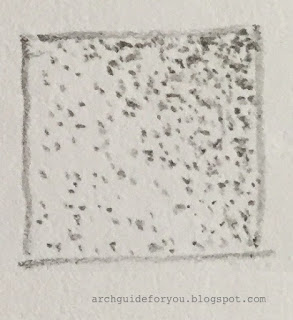"A line is a dot that went for a walk." Paul Klee (Swiss-German Artist)
Anyone who loves drawing and sketching will understand the above quote and the importance of a line as a basic drawing tool. A line defines a form, suggests a direction, gives texture and shows the tone.
In this post, we will learn some basic techniques with the pencil using dots, marks and lines. These techniques are the foundation for learning to sketch.
1. HATCHING
A bunch of lines in a particular direction will help in creating values and shades.
- The closer the lines are, the darker will be the value.
 |
| Closer the lines, the darker is the value. |
- Pressing the pencil harder will also give darker values.
 |
| From left to right: Closer the lines and pressing the pencil harder will give darker values. |
2. CROSS-HATCHING
Cross-hatching uses layers of hatching placed at an angle. The first layer is usually vertical, the second one is horizontal and the next one is diagonal. This technique is commonly used by most of the artists. For example, when you want to show the effects of lights, shades and shadow for a cube or other such 3D objects.
 |
| Cross Hatching |
3. CONTOUR HATCHING
The direction of lines suggests contour. Cross-hatching will suggest cross-contours. When hatching follows a contour it will suggest a 3D form. Contour hatching works best when you want to give 3D effects to objects such as fruits or flowers or other such natural shapes.
 |
| Left: Cross Contour Right: Hatching follows contour |
4. SCUMBLING
It uses layers of small scribbled marks by moving the pencil in small circular motion to suggest value and texture. When you vary the direction you can add more interest to the subject instead of using simple circular marks. You can create a variety of texture using this technique, for example, a coarse fabric, bushes, etc.
 |
| Scumbling |
5. RANDOM HATCHING
This technique uses layers of short straight marks. You can get a variety of textures using this depending on whether you use these hatches vertically, at an angle, following a contour or at random angles.
 |
| Random Hatching |
6. STIPPLING
This technique uses tiny dots to create value. The closer the dots are, the darker will be the tone. Farther apart the dots are, the lighter will be the tone. Larger dots can be used to give a coarse effect. This technique requires a lot of patience to master. Personally, I avoid it, for it is very time-consuming.
 |
| Stippling |
The six techniques shown using lines, dots and marks are some of the basic sketching techniques used for different purpose to create tones and textures.
 |
| Basic Sketching Techniques from my Sketchpad: Hatching, Cross-Hatching, Contour Hatching, Scumbling, Random Hatching, Stippling |


No comments:
Post a Comment